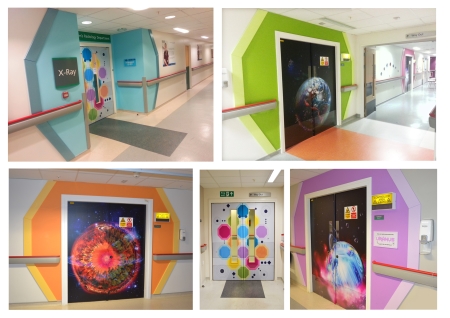The Patient Experience Class recognises excellence in design, encompassing internal, external and collaborative art projects. Here are details of this year's winners
Best External Environment
The judges considered:
- York Teaching Hospital NHS Foundation Trust for cancer care garden and walkway
- South Essex Partnership University NHS Foundation Trust for Cherry Tree Garden, Thurrock Community Hospital
- The Hillingdon Hospitals NHS Foundation Trust for Beaconsfield East Ward sensory garden
- Fira Landscape for Kirkwood Hospice garden
- Rowcroft Hospice for the Rowcroft inpatient garden
- Manchester Mental Health and Social Care Trust sensory gardens for dementia patients
Winner:
Rowcroft Hospice for the Rowcroft inpatient garden
The Rowcroft Hospice inpatient unit sits in 22 acres of unspoilt grounds in the centre of Torquay.
Following a fire, it was rebuilt in 1902 as a private residence. It was then run as a convalescent home until the late 1970s, finally being launched as a local hospice in 1982 by the Torbay Lions Club.
Currently it has capacity for 17 inpatients and all of the supporting elements to provide a holistic approach to palliative care.
In 2013 the Department of Health invited applications for capital grants to improve access to external spaces for patients, families and relatives. With the help of The Kings Fund and a landscape designer, the hospice working group consulted with representatives from the estates, nursing, administration and occupational therapy departments and patients and was able to create an outside area that was accessible from all the wards.
Facilities for three beds to be wheeled outside were included, along with discrete seating areas for more ambulant patients near to the wards. The centrepiece of the terrace is a water feature providing movement, sound and a calming influence. Subtle lighting continues the enjoyment of the garden and water feature area into the night, while ramps from the terrace allow journeys further away from the immediate ward area to other parts of the grounds such as the wild flower meadow, which was previously inaccessible.
Within the construction natural materials were used where possible, for example limestone slabs which remain non slippery when wet. The water feature is a 1.6m copper bowl and trees and plants were donated by families and relatives as well as being sourced from local nurseries. The railings are of low-maintenance stainless steel and all manholes and drainage have been cleverly designed to have minimal impact on the terrace area.
The judges said: “This is a garden redesign of the highest quality which has radically improved access for palliative care patients to the grounds of the hospice. The new terrace area blends exceptionally well with the building and the extensive grounds.
“The design is full of thoughtful touches including ramps for accessibility, the provision of parasols to provide shade, and electricity points so that beds can be wheeled out onto the terrace.”
Highly commended:
South Essex Partnership University NHS Foundation Trust for Cherry Tree Garden, Thurrock Community Hospital
The idea of creating a usable garden between Meadowview and Mayfield units at Thurrock Community Hospital dates back to 2009.
At the time the Alzheimer's Society approached the trust and asked if they could use part of the grounds to provide gardening activities for patients. Sadly, due to funding issues, this did not progress.
In early 2012 following concerns that the two dementia wards lacked adequate outdoor space, a small group of carers, volunteers and staff was formed and they were tasked to look at what could be done. The first step was to make improvements to the Meadowview Garden. This was extended and the trust created a safe garden using soft surface paths, artificial grass, seating areas, and safe planting.
Later that year, the trust successfully applied to The Kings Fund and was awarded £100,000. In August 2013 staff approached the Veolia North Thames Trust, which provided an additional £120,000, enabling the vision to take shape.
And, on 13 January this year, a turf-cutting ceremony was held to start the construction of a new dementia-friendly garden at Thurrock Community Hospital The purpose-built, therapeutic, eco-friendly garden space has been designed specifically for people with dementia. It incorporates circular paths with safety surfaces and seating areas, all surrounded by secure fencing with flowers and shrubs planted to attract wildlife. The garden provides a variety of experiences for visitors, patients and carers including a multisensory garden, a gardening area for those wishing to participate, the Four Seasons Cabin for meetings and refreshments, and a bandstand where entertainment can be staged.
Dee Susans, ward manager, said: “The aim is to provide a stimulating, interesting and secure garden so that anyone in the area can bring a relative or friend suffering from dementia to enjoy the garden and know that they will be completely safe.”
The judges added: “The redesign of the garden has involved the local community as well as people with dementia and their carers, all of whom will be able to benefit from the rejuvenated space. The thoughtfully-designed space will encourage walking and gardening activities as well as providing sheltered seating spaces.”
The Hillingdon Hospitals NHS Foundation Trust for Beaconsfield East Ward sensory garden
Described by the judges as ‘an excellent example of innovation in garden design within an acute hospital environment’, the fragrant and vibrant new sensory garden forms the centrepiece of the dementia-friendly refurbishment of Beaconsfield East Ward at Hillingdon Hospital.
Using a grant from the Department of Health’s Capital Investment Initiative, the focus for the pilot scheme was to create an environment that enhances the patient and carer experience through the provision of quiet and stimulating spaces inside and outside the ward.
Each area was designed to promote a sense of wellbeing, encouraging dignity and familiarity, while observing independence and security. The reconfiguration enabled the ward team to continue to specialise in rehabilitation and the garden has opened up a wealth of new therapy and nurturing opportunities with its looped pathway, sheltered seating areas, planters, and large terrace.
During the consultation process with staff, service users and their families, the last bed bay and side room of the ward were identified as a ‘tender care’ area. This instigated a palliative care approach for the design of the last side room with the addition of a private courtyard garden, separate from the main garden, where patient sand loved ones can enjoy some fresh air in privacy.
The main garden itself is split across two levels - the upper terrace and the lower garden – which are connected via a wide ramp and staircase. Views out to the landscape are now considered to be an essential part of a healthy holistic environment and upon arrival on the ward there are direct sightlines through to the space. The bed bays and dayroom also have glazed doors with lowered thresholds and open directly onto the upper terrace.
A sheltered seating area has been created under a sail-like structure outside the day room on the upper terrace while planters line the bed bay openings to add interest to the views from patients’ beds.
Flowering and espalier fruit trees have been incorporated, together with traditional garden plants and raised beds intended for therapeutic use.
Designed for low maintenance and including an irrigation system, the garden is lit at night via daylight sensors, while the decorative open-topped fence provides safe containment within sight of the nursing staff.
The judges said: “The design has been specifically tailored to the needs of patients with dementia and cognitive problems and their visitors. We particularly liked the inclusion of a private garden for palliative care patients.”
Best Internal Environment
The judges considered:
- Spire Bristol Hospital radiotherapy specialist care centre
- Kier Group for the Teenage Cancer Trust, Southampton General Hospital
- The Hillingdon Hospitals NHS Foundation Trust and Artinsite, Beaconsfield East Ward
- Bradford Teaching Hospitals NHS Foundation Trust for ‘Yorkshire at its Best’
- Gilling Dod Architects for Trinity Hospice
- Interserve and Devereux Architects for Colchester General Hospital radiotherapy
- Navigo for Harrison House
- Amcare Group home delivery service
- Llewelyn Davis for the Neuro Muscular Complex Care Centre
- P+HS Architects and Simons Medicinq for Queens Medical Campus Critical Care Expansion
Winner:
The Hillingdon Hospitals NHS Foundation Trust, Beaconsfield East Ward
A fusion of colour, art, sensory features and new social spaces distinguish the transformation of Beaconsfield East Ward at Hillingdon Hospital.
The 20-bed rehabilitation ward is aimed at older people, some of whom may have dementia or other forms of cognitive impairment.
Using a grant received from the Department of Health Capital Investment Initiative, the focus for the pilot scheme was to create a dementia-friendly environment that enhances the patient and carer experience through the provision of quiet and stimulating spaces both inside and outside the ward.
Refurbished areas include the bed bays, single rooms, an assisted shower room, staff base, reception, sensory room, occupational therapy kitchen and dayroom, all designed to complement the new sensory garden with its looped pathway and shaded seating areas.
There is new lighting for visual acuity, anti-slip cushioned flooring to prevent falls, clear pictogram signage, and co-ordinated furnishings.
Visitors are met by a front-of-house receptionist and there is an open-plan day/dining room and therapy kitchen. These areas have created new rehabilitation opportunities for social dining, breakfast clubs, group exercise classes, and sing-a-longs.
From the reception, visitors can clearly identify the staff base with its double-height, brightly-lit artwork and warm red colour theme.
The sensory room is tailored to suit older adults with comfortable seating, fibre optic strings and multimedia equipment to provide visual and auditory stimulation. It also provides a safe, non-clinical venue where patients and carers can meet with clinical teams and local support groups.
With views out to the garden, each four-bed bay and single room has its own feature colour – green, purple, magenta or blue – which is emphasised by co-ordinated furnishings. The bed bay colours are sequenced to ensure the middle bays can suit either male or female patients depending on the needs of the ward. Doors to patient toilets and bathrooms are also faced with yellow Whiterock and feature clear dementia-friendly signage.
Other additions include art totems on the corridor and murals on either side of the bays, with a distinct image above each bed helping patients to orient themselves and identify with their space. The well-spaced four bed bays now open out to the garden with lowered thresholds to aid access.
The judges said: “This is an exemplar; a very comprehensive ward refurbishment to meet the needs of frail elderly people and those with dementia. We particularly liked the use of colour and art to help with wayfinding, the provision of social space for patients and relatives, and the way the design has thoughtfully connected the internal and external environments.”
Artwork for the building was supplied by Artinsite.
Highly commended:
Kier Group for the Teenage Cancer Trust, Southampton General Hospital
“The enthusiastic involvement of young people is clear in the design of this 10-bed specialist cancer facility.”
This was the comment from the judges when deciding to commend efforts to enhance the Teenage Cancer Trust unit at Southampton General Hospital.
In September 2013, Kier Construction completed the new unit, creating a more-homely environment that supports teenagers and young adults through their diagnosis and treatment.
The unit features six inpatient ensuite bedrooms with sofa beds for family and friends; four day bays for teenagers and young adults; recreational and relaxation areas including a pool table, jukebox, smart TV and games consoles; a kitchen; and a parent and family room.
From inception to completion, the design team worked closely with an enthusiastic team of 16-24 year olds to create the best unit possible. Suggestions that have been used include an electronic fireplace in the bedrooms that can be changed to various scenes such as a roaring fire, a waterfall or a fish tank; and photo collages along the corridors of local things like Bestival and Southampton Football Club. Even a piece of fake grass from the unit’s turf-cutting ceremony which marked the start of construction has been incorporated.
Siobhan Dunn, chief executive of the Teenage Cancer Trust, said: “We have always wanted to build a unit at Southampton General Hospital and this amazing facility has some really unique features. That’s partly thanks to the design input we have had from the patients, but also thanks to the generosity of local communities who’ve worked so hard with us over four years to raise the money. This unit will help so many young people with cancer and their families feel less alone at an incredibly difficult time of their lives.”
Louise Hooker, the charity’s lead nurse at the hospital, added: “Even after just a few months we can already see how the new facilities are benefiting our patients and their families. By helping us to build this amazing ward, our local community supporters have done something very special for young people with cancer and I hope they feel as proud of the unit as we all do.”
Award for Best Collaborative Arts Project
The judges considered:
- UCLH ‘Arts and Heritage’ collaborative arts programme
- The Hillingdon Hospitals NHS Foundation Trust, Beaconsfield East Ward
- The Royal Children's Hospital Melbourne for ‘A Creative Approach to Hand Hygiene’
- Willis Newson for public art programme, Southmead Hospital, Bristol
- LIME Arts for the Starship X-ray department at the Royal Manchester Children’s Hospital
- Artstop Studios for the Roker and Mowbray Dementia Care Centre
- St Giles Hospice Arts into Health project
Winner:
LIME Arts for the Starship X-ray department at the Royal Manchester Children’s Hospital
Starship X-ray is an art and design project that has transformed the radiology department at the Royal Manchester Children’s Hospital, creating a child-friendly therapeutic space.
Staff and children requested the theme of ‘Space’ for the works. As there are nine camera rooms in the department and nine planets in the solar system, each room became a re-imagined planet, for example Neptune is the Planet of Oceans and Jupiter the Planet of Magnetism.
Reception is the Star-Ship Bridge and the journey is to the planets in the company of little robots. These ‘Raybots’ are small models made by the children and staff from redundant computer technology. The staff also helped children to make X-ray images of their toys that were used in the design work.
Significant involvement of patients, staff and families has ensured a true sense of engagement in, and ownership of, the project. All stakeholders were involved in the concept and design development through a series of group meetings, one-to-one sessions with staff, and creative workshops with children and their families. A special weekend was also held for staff to bring their children to.
This unique art and design project includes lightboxes, interactive digital play, 3D and 2D displays, large-scale artworks, furnishing and fabrication, signage, changing LED lighting, and a sound installation.
A radiologist in the unit said: “The lightbox that was installed in the CT room came into its own the day after it went in when we had a young boy who had previously really struggled to stay on the scanner lay quietly and count the butterflies and monkeys. His mum was nearly in tears as what has previously been a traumatic experience for them both was completed with ease and he came away smiling for the first time.”
The project was funded by the Thomas Cook Children’s Charity and was led by Lime Arts.
The BBH judges said: “This is an imaginative and innovative scheme that has integrated art into the design of a children’s X-ray department, providing distraction and making visits full of interest. The scheme is already bringing positive benefits to children, families and staff.”

LIME Arts was praised for its work on the Starship X-ray department at the Royal Manchester Children’s Hospital
Highly commended:
The Royal Children's Hospital Melbourne for ‘A Creative Approach to Hand Hygiene’
The Royal Children’s Hospital (RCH) is committed to providing best-practice paediatric healthcare, including the benefits of the creative arts to health and well being.
The new RCH building has been designed to embody, exemplify and celebrate creativity. It includes a wide range of spaces that are designed for creative arts practice and are suitable for performance and display.
Hand hygiene is the single-most-important tool for reducing hospital infections, but finding ways to continually embed the message can be challenging. This year the hospital decided to promote good hand hygiene via number of creative means.
It engaged the hospital community in creative arts activities with a pop-up art studio in Main Street every week throughout May, kicking off on World Hand Hygiene Day. Children, young people, families and staff all got involved in creating germ-themed artworks, encouraging discussion and learning about germs, where they come from, and how important it is to keep your hands clean. There were over 300 participants involved in the workshops.
Managers then went on to engage the wider hospital community with its Hand Hygiene campaign via an alternative medium – a silent disco. This uses Wi-Fi technology to enable participants to listen to music and the voice of an MC through individual headphones. Participants included patients, families, visitors, volunteers, staff and many of the executive team, who were led throughout various areas of the hospital listening to hand-themed songs and learning about good hand hygiene.
Having delivered direct participation activities and events, the hospital wanted to continue driving the message visually throughout the building. During the art activities participants’ hand prints were collected and these were reproduced, along with key hand hygiene facts, onto clear low tac vinyl. Over a period of weeks these were installed onto glazed areas.
“It was great fun for participants and observers and it created lots of buzz and talk around the hospital,” said Jennifer Gale, chief financial officer.
The BBH judges added: “This looked like great fun! It is a good way to engage both children and adults in communicating messages about the importance of hand hygiene.”


